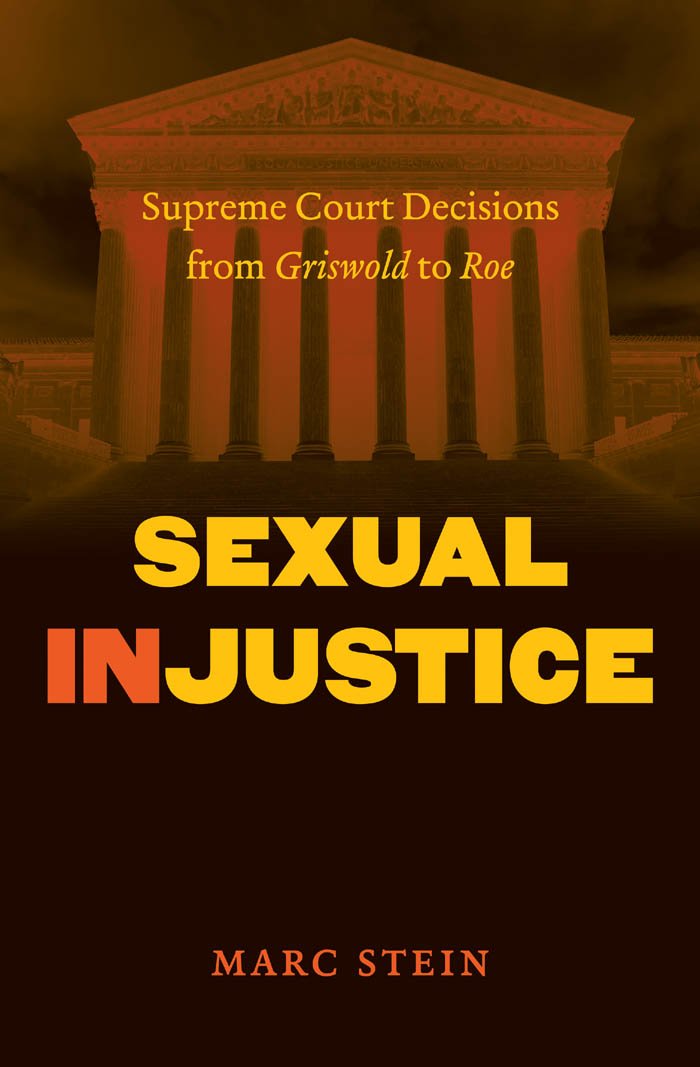Today, highly charged debates concerning gay marriage seem to influence political discourse across the country. Given the debate surrounding the extension of rights to homosexual relationships, Marc Stein's Sexual Injustice: Supreme Court Decisions from Griswold to Roe is a timely, and necessary, contribution to scholarship. Stein's work helps explain an important chapter in the quest to extend rights to homosexual Americans, while also critically examining the development of the constitutional right to privacy.

Sexual Injustice revolves around a series of Supreme Court decisions in the 1960s and 1970s, the height of the sexual revolution and during one of the most progressive periods in the Court's history. Stein brings a fresh perspective to the studied and landmark decisions Griswold v. Connecticut (1965), Fanny Hill v. Massachusetts (1966), Loving v. Virginia (1967), Eisenstadt v. Baird (1972), and Roe v. Wade (1973).
Many scholars have argued that the Supreme Court greatly expanded rights through "liberal" rulings on a variety of social issues regarding sexual freedom, such as abortion, interracial marriage, and birth control. The right to privacy was pivotal to these "liberal" decisions. Stein agrees that landmark rulings such as Roe v. Wade and Griswold v. Connecticut were cases that created and then liberalized the constitutional right to privacy. He further agrees that generally the Court did liberalize sexual freedoms for many Americans in the 1960s and 1970s.
The Court held that prohibition of birth control for use in marital relationships was unconstitutional in Griswold. Later, in Eisenstadt, the Court extended its ruling in Griswold to protect unmarried couples access to birth control. The Court struck down prohibitions on interracial marriage in Loving v. Virginia. Definitions of obscenity became narrower in Fanny Hill v. Massachusetts. Roe restricted the state's ability to regulate abortions. Yet these decisions, though revolutionary, were revolutionary only for many Americans, not all.
This much is largely familiar. Stein argues that despite the decisions that greatly enhanced sexual freedom for many Americans, the Supreme Court did not truly effect a sexual revolution, as so often has been assumed. Instead, despite the important liberalizing decisions, in the same context the Court issued another opinion, striking for its conservatism, and seemingly anomalous given the others: Boutilier v. The Immigration and Naturalization Service.
In a six to three decision in Boutilier, the Court held that "'homosexual' aliens could be excluded and deported from the country under the 'psychopathic personality' provisions of the 1952 Immigration and Nationality Act."
What does this tell us about the Court during this period? Stein argues the holding in Boutilier speaks volumes about the true nature of the Court at the time, and that nature is not entirely consistent with one that has been celebrated by liberals and condemned by conservatives. Instead, the holding is evidence of a much more tenuous commitment to a liberal sexually revolutionizing agenda. The Court's commitment, Stein argues, was to a specific, fairly narrow, view of sexual relations in the United States – those between a man and woman, preferably within the confines of marriage, monogamous, and potentially open to procreation.
The Court expanded these "heteronormative values" through its decisions, while marginalizing those, such as homosexuals, that did not fit into its vision of American sexual relations. The arguments presented to the Court and the opinions issued in its decisions favored some forms of sexual relations over others, and those favored forms did not leave room for homosexual relations. Stein finds that even in the dissenting opinions of Justices Brennan, Douglas, and Fortas, opinions that one would imagine would be more accommodating of diverse lifestyles, evidence of anti-homosexual sentiment is clear. The Court clearly favored expanding the sexual freedoms of some groups, and keeping those of others restricted or even, as in the case of homosexuals, prohibited.
In addition to contributing to scholarship in the fields of legal history and sexuality, Stein's work also informs immigration history. Stein suggests that homosexuals were understood to be sexual deviants, and immigration law endeavored to exclude all who engaged in deviant sexual behavior through the use of the phrase "psychopathic personalities."
However, the legislative intent behind the 1952 Immigration and Nationality Act is decidedly less clear. Stein points to evidence that the Court interpreted the act broadly, despite distinctions created through wording between "sexual deviants," "homosexuals," "sexual perverts," and "psychopathic personalities." In addition, Stein draws comparisons between how homosexuals were treated and Chinese immigrants, because both groups were discriminated against in the immigration context for their characteristics rather than conduct. Since Boutilier was fundamentally an immigration case, the focus on the intersection of law, immigration policy, and homosexuality in the mid-twentieth century is both warranted and illuminating.
Perhaps Stein's most important accomplishment in this book is to challenge some of the basic assumptions many scholars and Americans share about the history of the Supreme Court in the twentieth century. In essence, Stein contends that the liberalizing forces at work during the 1960s and 1970s were important, but that they also have been misleading; historians' emphasis on the liberal decisions have overshadowed and neglected other, more conservative decisions, painting a picture that is both inaccurate and incomplete.
Sexual Injustice forces one to question what we thought we knew about the "liberal" Court of the 1960s and 1970s, and instead, forces one to acknowledge that many more conservative elements were at play in judicial decision-making than previously thought. It is a masterfully written work that is truly thought provoking on a topic that deserves more inquiry by historians and legal scholars alike.
